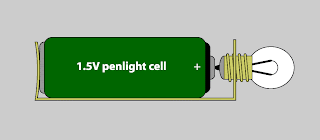Section 1: Introduction to Electricity (විද්යුතයට හැඳින්වීමක්)
Electricity is one kind of Physical Energy (Physical Energy is the ability to do a Physical Work). So we can use electricity to do work. Usually when use electricity we convert Electrical Energy to other form of energy (Mechanical, Thermal, Light etc.) using a particular device (Motor, Heater, Bulb etc.)
විදුලිය යනු භෞතික ශක්ති ප්රභේදයකි (භෞතික ශක්තියක් යනු භෞතික කාර්යයක් කිරීමට ඇති හැකියාවයි). විදුලිය ශක්තියක් බැවින් විද්යුත් ශක්තිය භෞතික කාර්යයන් ඉටු කරගැනීමට ප්රයෝජනයට ගත හැකිය. අප විදුලිය ප්රයෝජනයට ගැනීමෙදි සිදු කරනු ලබන්නේ විද්යුත් ශක්තිය වෙනත් ශක්ති ආකාරයක් (චාලක, තාප, ආලෝක ආදී වූ) බවට උපකරණයක් භාවිතයෙන් (විදුලි මෝටරය, තාපක, විදුලි බල්බ ආදී වූ) පත් කර ගැනීමයි.
Section 2: Physical Characteristics of Electricity (විද්යුතයේ භෞතික ගුණ)
We can identify two Physical Characteristics in Electricity (Electrical Energy).
1. Voltage
Voltage is the "Electrical Potential difference between two points" or "The difference in electrical potential energy of an Unit Charge transported between two point". This characteristic first identified by Italian physicist Alessandro Volta. To honor Alessandro Volta, the unit for measuring voltage has been named as "Volt" and symbol in SI units is "V" (E.g. 1.5V in size AA battery, 230V supply for house holds, 33kV in transmission line etc.)
2. Current
Electric Current is "A flow of electric charge". Electric charge flows when there exists an Electrical Potential difference between two points of a conducting medium, or in other words when a voltage applied to conducting medium an electric current exists in that medium. The "Electric current" first introduced by French physicist Andre-Marie Ampere. To honor Andre-Marie Ampere, the unit for measuring current has been named as "Ampere" and symbol in SI units is "A". (E.g. 5A plug base, 100A DDLO fuse etc.)
විද්යුත් ශක්තියට/ විදුලියට භෞතික ගුණ දෙකක් පවතී.
1. වෝල්ටීයතාවය
වෝල්ටීයතාවය "යම් ලක්ෂ්යයන් දෙකක් අතර පවතින විභව අන්තරයයි" නැතිනම් "ඒකක ආරෝපණයක් එක් ලක්ෂ්යයක සිට වෙනත් ලක්ෂ්යයකට ගෙන යෑමෙදි කළ යුතු කාර්ය්ය ප්රමාණය" ලෙස අර්ථ නිරුපණය කෙරේ. මෙම භෞතික ගුණය ලොවට හඳුන්වා දෙනු ලැබුවේ ඉතාලි ජාතික භෞතික විද්යාඥයකු වන අලෙස්සැන්ඩ්රො වෝල්ටා විසිනි. එතුමන්ට ගරු කිරීමක් ලෙස වෝල්ටීයතාවය මැනීමේ අන්තර්ජාතික සම්මත ඒකකය වෝල්ට් ලෙස නම් කර ඇති අතර සංකේතය ලෙස ඉංග්රීසි කැපිටල් V අකුර භාවිතා කරයි. ( උදාහරණ: 1.5V බැටරිය, 230V ගෘහස්ත විදුලි සැපයුම, 33kV විදුලි සම්ප්රේෂණ පද්ධති)
2. ධාරාව
විද්යුත් ධාරාව යනු "එක් ලක්ෂ්යයක සිට වෙනත් ලක්ෂ්යකට ආරෝපණ ගලා යෑමයි". සන්නායකයක ලක්ෂ්ය දෙකකට විභව අන්තරයක් (වෝල්ටීයතාවයක්) ලබා දුන් විට එම ලක්ෂ්ය දෙක අතර විද්යුත් ධාරාවක් (ආරෝපණ ධාරාවක්) ගලා යනු ලැබේ. විද්යුත් ධාරාව යන භෞතික ගුණය ලොවට හඳුන්වා දෙනු ලැබුවේ ප්රංශ ජාතික භෞතික විද්යාඥයකු වන ඇන්ඩෟ මරේ ඇම්පියරේ විසිනි. එතුමන්ට ගරු කිරිම පිණිස විද්යුත් ධාරාව මැනීමේ අන්තර්ජාතික සම්මත ඒකකය ඇම්පියර් ලෙස නම් කර ඇති අතර සංකේතය ලෙස ඉංග්රීසි කැපිටල් A අකුර භාවිතා කරයි. (උදාහරණ: 5A විදුලි පේනු, 100A විලායක)
Quick Links for More Readings
- About Alessandro Volta http://en.wikipedia.org/wiki/Alessandro_Volta#Volta_and_Galvani
- About Andre Marie Ampere http://en.wikipedia.org/wiki/Andr%C3%A9-Marie_Amp%C3%A8re

No comments:
Post a Comment